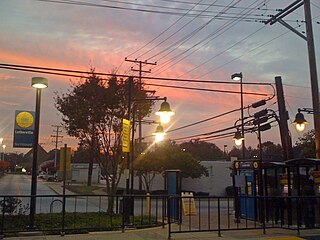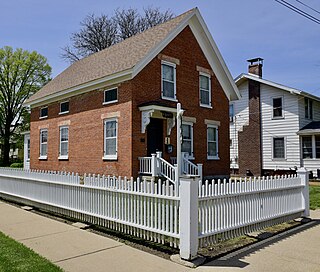
Bond County is a county located in the U.S. state of Illinois. As of the 2020 census, the population was 16,725. Its county seat is Greenville.

Polo is a city in Ogle County, Illinois, United States. The population was 2,355 at the 2010 census, down from 2,477 in 2000.

Orangeville is a village in Stephenson County, Illinois. The town's sign lists the population at 800 as of January 2021. The population in 2020 was 738. The population according to the 2010 census was 793, up from 751 in 2000. Using the 2020 population of 738 Orangeville is the 741st largest city in Illinois and the 11,650th largest city in the United States. Orangeville is currently declining at a rate of -0.94% annually and its population has decreased by -6.94% since the 2010 census. The area's earliest white settlers arrived in the year 1833, and the village was platted in 1851 by John Bower, who is considered the village founder. In 1867 Orangeville was incorporated as a village. The town's central business district contains several 19th century commercial buildings, many of which were built during the railroad boom of 1888–1914. By the time the Great Depression was ongoing, business in Orangeville had started to decline, with the last bank closing in 1932. In 1956 another bank started operating in the village and is still in town today. Some recent infrastructure jumps have restored some of the village's old decor.

Aplington is a city in Butler County, Iowa, United States. The population was 1,116 at the 2020 census.

The Lincoln Log Cabin State Historic Site is an 86-acre (0.3 km²) history park located eight miles (13 km) south of Charleston, Illinois, U.S., near the town of Lerna. The centerpiece is a replica of the log cabin built and occupied by Thomas Lincoln, father of U.S. President Abraham Lincoln. Abraham Lincoln never lived here and only occasionally visited, but he provided financial help to the household and, after Thomas died in 1851, Abraham owned and maintained the farm for his stepmother, Sarah Bush Lincoln. The farmstead is operated by the Illinois Historic Preservation Agency.

Lutherville is a census-designated place (CDP) in Baltimore County, Maryland, United States. As of the 2010 census it had a population of 6,504. Prior to 2010 the area was part of the Lutherville-Timonium CDP. Within its borders lies the Lutherville Historic District.

The Ruben M. Benjamin House is a house in Bloomington, Illinois. It is a two-story rectangular building, styled in the Classical Revival architectural motif. It was built in 1856 John L. Routt, who would become the first governor of Colorado. Ruben M. Benjamin, an attorney known for litigation relating to railroad regulation, lived in the home for more than 60 years. The United States National Register of Historic Places added the Ruben M. Benjamin House in August 1978.

Buffalo Grove Lime Kiln is one of two old lime kilns in Illinois listed on the National Register of Historic Places. The other is the Griggsville Landing Lime Kiln in Pike County. Buffalo Grove Lime Kiln is located near the Ogle County city of Polo. When in use, the kiln would have produced raw quicklime. The lime kiln was added to the National Register in 2002.

Illinois Carnegie Libraries Multiple Property Submission was a National Register of Historic Places Multiple Property Submission in the U.S. state of Illinois, approved on February 16, 1994. The submission included a group of sixteen Illinois libraries whose construction was funded by early 20th century philanthropist Andrew Carnegie. The sixteen libraries were all added to the National Register of Historic Places between 1978 and 2002.

Pullman National Monument, also known as the Pullman District and Pullman Historic District, is located in Chicago and was the first model, planned industrial community in the United States. The district had its origins in the manufacturing plans and organization of the Pullman Company and became one of the most well-known company towns in the United States, as well as the scene of the violent 1894 Pullman strike. It was built for George Pullman as a place to produce the famous Pullman sleeping cars.

Buffalo Grove is an unincorporated community in the Ogle County township of Buffalo, Illinois, United States. It was the first settlement in Ogle County, and was once a bustling frontier town that attracted many of Ogle County's early residents. The creation of the Illinois Central Railroad, caused most of the residents and businesses to move to Polo. Today this former hub of business comprises a few dozen homes.

The William H. Seward House Museum is a historic house museum at 33 South Street in Auburn, New York. Built about 1816, the home of William H. Seward (1801-72), who served as a New York state senator, the governor of New York, a U.S. senator, a presidential candidate, and then Secretary of State under presidents Abraham Lincoln and Andrew Johnson. The house was declared a National Historic Landmark in 1964, and added to the National Register of Historic Places on October 15, 1966. It is now maintained by nonprofit organization as a museum dedicated to Seward's legacy.

The Owen Lovejoy House is a historic house museum on East Peru Street in Princeton, Illinois. Built in 1838, it was for many years home to Owen Lovejoy (1811-1864), a prominent abolitionist and congressman. Lovejoy was an open operator of shelter and support on the Underground Railroad, and his house contains a concealed compartment in which escaped slaves could be hidden. It was declared a National Historic Landmark in 1997. It is open seasonally or by appointment for tours.

The Alvin T. Smith House is a two-story home on Elm Street in Forest Grove, Oregon, United States. Completed in 1856, it is the second oldest building in the city and was added to the National Register of Historic Places in 1974. A Greek Revival style house, it was built by pioneer Alvin T. Smith beginning in 1854.

The Cushing Hotel is a historic hotel in Afton, Minnesota, United States, established in 1867 to cater to railroad workers, lumbermen, and travelers. The hotel was listed on the National Register of Historic Places in 1985 for having local significance in the theme of commerce. It was nominated for exemplifying the commercial lodging common to mid-19th-century river towns. It remains in business as the Afton House Inn.

Henderson Hall Historic District is a National Register of Historic Places (NRHP)-listed historic district in Boaz, Wood County, West Virginia. The primary contributing property is Henderson Hall, a home in the Italianate style from the first half of the 19th century. Other residences at the site are a tenant house from the end of the 19th century, and "Woodhaven", the 1877 home of Henry Clay Henderson. Additional structures include a smokehouse, two corn cribs, a carriage barn that also served as a schoolhouse, a scale house used for storing agricultural equipment, and two barns. Also included within the district are the 19th-century Henderson family cemetery, a wall, a mounting block, and three mounds associated with the pre-Columbian Adena culture.

The Cattle Bank is a historic bank building located at 102 E. University Ave. in Champaign, Illinois. Built in 1858, it is the oldest documented commercial structure in Champaign. It opened as a branch of the Grand Prairie Bank of Urbana, Illinois. Champaign was the southern terminus of a railroad line to Chicago, so cattle raisers from the surrounding area drove their cattle to Champaign to ship them to the Chicago market. The Cattle Bank provided banking and loan services to these cattlemen. The building housed a bank for only three years. During that time, U.S. President Abraham Lincoln is known to have cashed a check there. From 1861 to 1971, the building housed several commercial tenants. It was added to the National Register of Historic Places in 1975 and renovated in 1983. Since 2001, the Cattle Bank has been home to the Champaign County History Museum.

The Harvey Lee Ross House is a two-story frame, side-gabled house built in approximately 1858 on the farm of Harvey Lee Ross near Vermont, Illinois. The house and several outbuildings were added to the National Register of Historic Places (NRHP) in 1996, based on the distinctive characteristics of the architecture and an association with the life of a significant individual from the past. The house features Greek Revival elements with some Italianate detailing. It was originally owned by Harvey Lee Ross, a railroad developer, banker, merchant, and agriculturist.

The Dr. William Burns House is a historic house at 201 N. Franklin Avenue in Polo, Illinois. The house was built in 1854 for Dr. William Burns, Polo's first medical doctor and one of its most prominent early citizens. After working as a traveling doctor, Burns began practicing in nearby Buffalo Grove in 1848; like much of Buffalo Grove, he moved to Polo after an Illinois Central Railroad station opened there. Burns' house, the first brick house in the city, had a vernacular gable front plan; such homes were popular at the time, especially in newly formed railroad towns. Burns lived in the house until he moved to a larger one in 1868; he went on to serve as Polo's mayor, a town council and school board member, and a financial benefactor of the city.





















